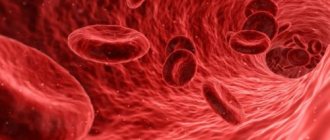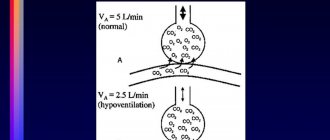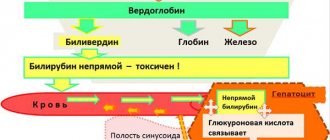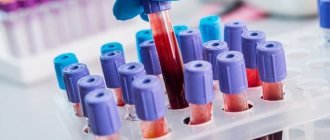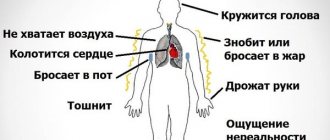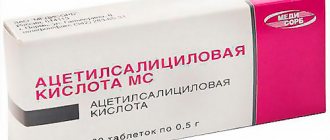Causes of the disease
The disease is more common in men than in women. Varicose veins in the groin develop due to a hereditary predisposition and prolonged stay in one position.
There are other causes of varicose inguinal pathology. These include:
- increased intra-abdominal pressure;
- presence of excess body weight;
- intense physical activity;
- presence of bad habits.
When several factors causing the disease are combined, the likelihood of varicose veins in the groin area increases several times.
Clinical picture of the disease
There are four stages of disease manifestation:
- At this stage, the disease is asymptomatic. There may be discomfort in the scrotum area. At this stage, the disease can be diagnosed using instrumental techniques, in particular ultrasound;
- In the second stage of the disease, protruding veins are clearly visible without any medical devices. A person’s libido weakens, and a feeling of heaviness in the genital area may appear. The scrotum often looks asymmetrical: one half of it is significantly larger than the other in size;
- At the third stage of the disease, swelling may appear at the site of the lesion, and sharp pain in the groin may occur;
- The veins increase significantly in size. In severe cases, body temperature may rise and the process of sperm development slows down.
Characteristic symptoms of the disease
At the initial stage, the disease is asymptomatic. Many patients prefer not to pay attention to the first signs of varicose veins in the groin. Some males experience pain in the groin area. In most cases, they occur during urination and during erection.
In women, the main symptoms of the disease are nagging pain in the groin area, and irritation of the vaginal mucosa may occur.
With the rapid progression of the disease, the following characteristic signs are observed:
- formation of varicose nodes in the groin;
- sharp pain in the area of the affected vessels. It intensifies after hard physical work, during which the flow of blood to the lower half of the body increases.
Diagnosis of pathology
Enlarged veins in the groin should not be ignored. When the first signs of illness appear, you should seek medical help. The doctor examines the veins by palpation and, if necessary, will refer the patient for an ultrasound examination.
If a patient is suspected of having varicose veins in the groin area, phlebography is also performed, which allows one to obtain complete information about the condition of the affected vessels.
Varicose veins can cause infertility, so a representative of the stronger sex of reproductive age should take a spermogram, which will determine the patient’s ability to conceive a baby.
Causes
Inguinal varicose veins are a scourge of any age category that can develop during puberty. If neglected, it can cause irreversible consequences, and delayed seeking medical help complicates the process of treating varicose veins in the inguinal veins in men.
In the early stages of the disease, it could be eliminated without any problems, but in the later stages it is a long process that requires an integrated approach to treatment.
It is difficult to determine a separate reason for the development of vascular disorders. This is usually a consequence of pathological changes in normal blood flow, progressing under the influence of negative external and internal conditions.
The causes of the appearance of varicose nodes in the groin area are called dysfunctions of various etiologies. Such pathologies are associated in men with many factors: from youthful masturbation and Viagra in old age, to a sedentary lifestyle and intense sports.
Very often, it is office workers, cooks, waiters, hairdressers, pharmacists, teachers, loaders, and other general workers who turn to the doctor with the problem of varicose veins.
Treatment of inguinal varicose veins in men is urgently necessary, because otherwise the progression of the condition leads to the need for surgical intervention.
Varicose veins in the groin of women can develop during pregnancy, as a result of pressure from the enlarged uterus with the fetus, or squeezing of blood vessels. In men, varicose veins in the groin can develop for other reasons.
The most common of them include:
- hereditary anomalies in the structure of blood vessels or genital organs;
- problems with sexual activity (masturbation, taking stimulants, prolonged absence of sexual intercourse, artificially prolonging its duration);
- intense loads during systematic sports or in gyms;
- heavy physical work associated with lifting and moving heavy objects;
- sedentary lifestyle, hemorrhoids, stool disorders associated with it (pathological constipation and diarrhea);
- injuries to the groin area (penis):
- chronic infectious and inflammatory processes in the reproductive system;
- hormonal imbalances (excess or deficiency of male sex hormones);
- vascular atherosclerosis and excess weight associated with poor nutrition and bad habits;
- oncological tumors or hernias.
The appearance of varicose veins in the groin in men can also develop against the background of a combined effect of causes that contribute to a more rapid progression of the pathology. The symptoms of varicose veins in the groin in men depend on the location of the lesion and the degree of its development.
Treatment tactics are determined by the symptoms that appear: at an early stage they are practically invisible and are ignored by most patients. The longer treatment is delayed, the more difficult it is to eliminate the consequences and normalize the patient’s condition.
Risk factors
Inguinal varicose veins in men often develop due to the influence of the following factors:
- infectious diseases;
- the use of interrupted sexual intercourse as a method of preventing unwanted pregnancy;
- long-term use of anesthetics;
- promiscuous sex life.
Among the fair sex, varicose veins in the groin often develop during pregnancy, hormonal imbalance in the body, thinning of the walls of blood vessels located in the pelvic area, and deficiency of certain vitamins.
Classification of varicose veins in the groin in men
Varicose veins in the groin in men are of two types:
- varicocele;
- varicose veins of the penis.
In approximately 20% of cases, the veins located on the scrotum are affected. This purely male disease is called varicocele.
Representatives of the stronger sex are also diagnosed with varicose veins in the area of the penis. Enlarged veins on the penis not only look unsightly. They cause a lot of inconvenience to the patient. At a late stage of the disease, varicose nodes form and trophic ulcers occur. These pathological changes are especially noticeable during erection.
Varicocele in males
The following problems can lead to the occurrence of varicocele:
- the presence of tumors in the pelvic area;
- congenital deformation of blood vessels located on the testicles;
- the patient has an inguinal hernia;
- dysfunction of the digestive organs;
- long-term sexual abstinence.
Varicocele can cause infertility in males. With this pathology, blood circulation in the groin area is impaired. This negatively affects sperm development.
Pathology of the penis
The penis is equipped with a huge number of veins and arteries. During sexual arousal, they often protrude above the surface of the skin. This is considered to be the norm. But in a healthy man, the diameter of the veins does not exceed 4 mm. They are painted light blue.
Varicose veins in the groin area appear due to stagnation of blood. With excess pressure, the walls of blood vessels are subject to deformation, the tone of the veins deteriorates, and the strength of the muscle layer decreases.
The main causes of the disease include:
- increased blood clotting;
- injury to the head of the genital organ;
- thrombophlebitis;
- surgery on the penis.
Causes of varicose veins in women in the groin
Most women associate varicose veins with constant heaviness in the lower extremities, swollen veins and regular discomfort that occurs during prolonged walking or sitting. However, varicose veins do not always affect the lower extremities; quite often they affect the pelvic area, in particular the groin area and genitals.
This type of disease causes a lot of inconvenience for the fair sex, significantly limiting their quality of life. According to statistics, varicose veins in women in the groin most often appear during childbearing age, but there are exceptions.
In addition, many cases of successful treatment of this disease have been described in medicine, but a favorable outcome is not always possible, since ARVMT is difficult to diagnose, especially at an early stage.
Causes
The cause of varicose veins of the small pelvis is connective tissue dysplasia. This deviation represents a partial dysfunction of the connective tissue and a partial disruption of its structure.
Moreover, such changes occur not in a local area, but throughout the entire body.
One of the possible consequences of connective tissue dysplasia is the weakening of vascular walls, mostly those in which the amount of muscle tissue is negligible, in the veins, for example.
The occurrence of tissue dysplasia can be facilitated by unfavorable environmental conditions and even the ordinary effects of the fetus on the body during pregnancy. However, there are other reasons as a result of which varicose veins appear in women in the groin and pelvis:
- The presence of several gynecological diseases in a woman (retroflexion, salpingitis, endometriosis and others);
- Anorgasmia (regular interrupted sexual intercourse, used as a method of contraception);
- Hormone replacement therapy;
- Backbreaking physical labor;
- Constant sedentary or standing work;
- Frequent pregnancy and childbirth;
- Disorders of the menstrual cycle;
- Long-term use of hormonal contraception;
- Increased estrogen levels;
Quite often, varicose veins in women in the groin area provokes reflux through the sphenofemoral anastomosis, spreading into the external genital vein system and along the posterointernal tributary of the great saphenous vein. But the trigger for this disease is, of course, pregnancy. But at the same time, only two to ten percent of pregnant women retain URVMT after childbirth.
Signs
Among the visual symptoms, the first to be noted are enlarged veins on the upper thighs, genitals, buttocks and groin.
Also, some women experience increased discharge from the perineum for no apparent reason.
The list of common symptoms of the disease is much wider; this is a “dull” pain in the lower abdomen, radiating to the groin and lower back, intensifying immediately before the onset of menstruation.
This is also increased pain syndrome that occurs due to prolonged standing, sitting or excessive physical activity. In rare cases, the pain becomes unbearable right during sexual intercourse. With ARVMT, pain in the groin area appears constantly and is often accompanied by urination disorders.
For the convenience of diagnosing varicose veins in the pelvis, the disease was divided into three degrees, each of which is determined by the localization of venous ectasia and the diameter of dilated vessels:
- The diameter of the veins does not exceed five millimeters (this means any venous plexus of the small pelvis), the course of the vessels is “corkscrew-shaped”.
- The diameter of the veins varies from six to ten millimeters. The second degree of ARVMT is accompanied by scattered ectasia of the ovarian plexus, swelling of the parametric veins and expansion of the arcuate plexus of the uterus.
- Total dilatation of veins - from ten millimeters, is accompanied by a main type of parametric location.
Diagnostics
Thanks to modern ultrasound diagnostic methods, varicose veins in women in the groin are successfully detected at the earliest stages. However, ultrasound alone is not always enough to definitively confirm the diagnosis; doctors often additionally prescribe ovaricogaphy or venography.
But this does not always happen; in clinical practice, cases of duplex scanning of the small pelvis by transvaginal (through insertion into the vagina) and transabdominal (through the anterior peritoneum) methods are common.
This is the most ordinary ultrasound examination, only with better visualization. If it is necessary to clarify the presence of third-party pathologies of the pelvic organs in a woman, then in such cases computed tomography is used.
Laparoscopy is used extremely rarely, and if it is used, it is usually transformed into a procedure for ligating the ovarian veins.
Read on topic: Varicose veins on the labia
Treatment
This type of treatment is usually used for first and second degree varicose veins.
The standard treatment course includes regular physical therapy and the use of venotonics (a nonspecific anti-inflammatory drug).
Additionally, symptomatic treatment is provided, increased physical activity is eliminated and, if possible, working conditions are adjusted (change of workplace).
Among other things, conservative treatment also applies to the daily diet. It should be dominated by fruits and vegetables, vegetable oil. It is recommended to abstain from smoking and drinking alcoholic beverages for a while or give them up forever. Additionally, every day you need to take a contrast shower, directing a stream of rising water directly to the groin.
Unloading exercises like “bicycle”, “scissors” or “birch tree” are especially effective in treating varicose veins. They are recommended to spend at least half an hour daily, dividing the sessions into morning training and evening training. After evening workouts, the next day you feel better, sometimes even the pain goes away.
It is imperative to choose therapeutic compression hosiery and wear it constantly. In such underwear, the veins receive additional help, as a result of which blood flows much better from the pelvis, lower extremities and buttocks.
Among venoactive drugs, Detralex is most often prescribed in a standard dose. After just two and a half to three months of taking this medication, women notice a general improvement in their condition and a decrease in pain. Varicose veins in women in the groin often affect the menstrual cycle, so to alleviate it, Detralex should be taken a few weeks before menstruation.
If the above-described conservative treatment methods do not alleviate or improve the patient’s condition, surgical treatment is used in such cases. The same applies to the third degree of the disease, which most often they do not try to cure using conservative methods, but immediately proceed to surgery.
Read on topic: Cream for pregnant women for varicose veins - tips for choosing
In addition to surgical treatment, modern medicine can also offer the method of laser coagulation. The essence of this procedure comes down to the introduction of special conductors into the affected veins, which glue the vein walls together with subsequent exposure to a laser beam.
After the operation, the treated veins gradually lose their function and dissolve after some time. There is also a chemical method for treating varicose veins, which differs from the previous method only in that not a conductor is inserted into the vein, but another substance - a sclerosant, which glues the veins together without the help of a laser.
Both treatment methods are very effective, since reoperation is required in only 1.5% of cases.
Varicose veins in women
Varicose veins located in the perineal area are characterized by the following symptoms:
- swelling of the labia;
- the appearance of varicose nodes;
- pain in the intimate area;
- the appearance of age spots on the labia.
Varicose veins located between the legs in women occur quite rarely. The disease often occurs during pregnancy against the background of varicose veins of the extremities or pathology of the uterine veins.
Varicose veins in the groin during pregnancy
With this pathology, the walls of the affected vessels become thinner, which increases the likelihood of damage to the veins and severe bleeding during childbirth.
The following factors lead to the appearance of varicose veins during pregnancy:
- increasing load on the spine;
- increased progesterone levels during pregnancy;
- mechanical compression of veins when wearing tight underwear.
For varicose veins that develop during pregnancy, it is recommended to take a contrast shower. It helps increase the strength of venous walls. A woman should wear special underwear. Before purchasing compression tights, you should consult your doctor.
If you have varicose veins during pregnancy, you need to adjust your diet. The daily menu of the expectant mother should include dishes made from vegetables and fruits.
When should you go to the doctor?
There is no doubt that an increase in the size or deformation of the veins in the groin area in men is not a pathology that requires urgent treatment. But a representative of the stronger sex should not ignore the problem or use medications without the consent of the doctor.
If the degree of damage to the veins is high, a visit to a medical facility should not be postponed. If you have the following complications, you should consult a doctor immediately:
- severe pain in the groin area that does not disappear after taking non-steroidal anti-inflammatory drugs;
- increased body temperature;
- the appearance of ulcers at the site of the dilated vein.
Which doctor should you visit?
If you suspect a disease such as inguinal varicose veins, you should consult a physician. Pain in the legs can be a symptom of other pathologies. The therapist can give a referral to a specialist phlebologist or angiologist. An angiologist treats blood vessels using therapeutic and surgical techniques.
A phlebologist helps to cope with the symptoms of the following pathologies:
- varicose veins;
- trophic ulcers;
- venous insufficiency;
- trophic ulcers.
Diagnostics
Varicose veins or deformation of the veins in men in the groin in an unadvanced form do not require urgent intensive care. However, the problem should not be left unattended, especially if the first symptoms begin to appear. You should consult with a therapist who will refer you to a specialized specialist - a phlebologist. The doctor will perform a palpation method and examine the vessels in the groin area with ultrasound. Additionally, he may prescribe an X-ray contrast study (phlebography), which will provide comprehensive information about the condition of the vessels in the groin. Since varicose veins in the groin can lead to infertility, therefore, a mandatory analysis during a diagnostic examination should be a spermogram, which will determine a man’s ability to conceive a child.
Modern methods of treating the disease
Varicose veins in the groin, which occurs in men and women, require wearing special compression garments. Medicines for varicose veins are also used to treat the disease.
In the early stages of the disease, the following medications are prescribed:
- anti-inflammatory drugs intended for topical use;
- analgesics that relieve pain;
- anticoagulants. These medications help thin the blood and reduce the risk of blood clots.
If conservative treatment is ineffective, surgical intervention is necessary.
Treatment of varicose veins in the groin
Depending on the severity of the disease, conservative treatment or surgical intervention may be prescribed. Let's look at the types of therapy in more detail.
Conservative therapy
This type of impact on pathology involves the use of medications. It is usually prescribed for stages 1 and 2 of the disease. To eliminate the problem, the following medications are prescribed:
- Non-steroidal anti-inflammatory drugs. They help eliminate inflammatory processes in the area of the dilated vein, which makes it possible to relieve the unpleasant symptoms that accompany the disease. For this, the following medications are used: Ibuprofen, Diclofenac, Ibufen, etc.
- Anticoagulants. This group of drugs is intended to normalize blood circulation at the local level. The use of anticoagulants helps prevent the formation of blood clots in the dilated vein. The most common drugs in this group are: Viatromb, Heparin, Angioflux, Thrombogel 1000. As well as their analogues. These medications are produced in the form of ointments for topical use.
- Venotonic drugs. The use of medications in this group allows you to normalize the functioning of blood vessels in the groin area. They have a tonic effect on swollen veins. For this purpose, the following medications are prescribed: Troxevasin, Lyoton, Glivenol, Venoruton, Aescusan and others.
- Medicines for swelling. These drugs have a symptomatic effect, eliminating swelling in the affected area, thereby they can relieve pain. The most effective medications in this group are: Phlebodia, Detralex, as well as products with a similar composition.
During the period of drug treatment, sexual intercourse is contraindicated for a man.
Surgical intervention
Surgery is usually prescribed for men under 30 years of age when extensive dilation of blood vessels is diagnosed. This helps avoid infertility in the future. There are several types of surgery to correct this problem. These are:
- Laser coagulation. This type of operation involves applying a laser beam to the affected vessels to improve their patency. The operation is performed under local anesthesia. The advantage of laser coagulation is the absence of a rehabilitation period. A man can return to his normal lifestyle the very next day.
- Scleroplasty. The essence of this intervention is the introduction of a special medicinal solution into the dilated veins, which restores normal blood circulation and cleanses the vessel. Scleroplasty is performed under local anesthesia. The rehabilitation period also does not take much time.
- Traditional surgical intervention. This is a classic type of operation that should be performed under general anesthesia. Its essence is to eliminate problem areas of the vein using a scalpel. This treatment method requires rehabilitation, which lasts 1 week. All this time the patient must remain in a hospital setting under the supervision of specialists.
Possible complications of the disease
Varicose veins in the groin can cause infertility or erectile dysfunction in the stronger sex
The disease can lead to the following consequences:
- thrombosis;
- excessive bleeding due to accidental injury to a vein;
- an inflammatory process that affects the vascular walls;
- formation of trophic ulcers.
When is surgery necessary?
Surgery is necessary in case of extensive damage to the veins and a high risk of complications.
The following indications for surgery should be highlighted:
- testicular atrophy;
- adolescence of the patient;
- high probability of infertility;
- severe bleeding, which can lead to thrombosis;
- presence of scars in the testicular area.
In case of severe bleeding, thrombectomy is performed. After removal of the blood clot, the patient’s well-being noticeably improves. Thrombectomy is considered to be a relatively safe surgical operation.
For varicose veins in the groin area, laser coagulation is also performed. During the surgical operation, the patient does not experience any discomfort. When using laser coagulation, general anesthesia is not required, so the patient can return to normal life within 24 hours. After medical intervention, no scars or cicatrices remain, and the likelihood of complications is extremely low.
Diagnosis and treatment
Correct diagnosis is already half of successful treatment. In order to accurately make a diagnosis, the doctor must prescribe a number of laboratory and instrumental studies:
- palpation of the affected area and visual inspection;
- functional tests;
- laboratory blood tests;
- dopplerography;
- angiography;
- duplex scanning.
Based on the information received, the doctor prescribes conservative or surgical treatment. Traditional medicine involves the use of venotonics for topical application:
Anticoagulants Clexane and Fraxiparine, drugs for edema - Phlebodia 600, Detralex, antiplatelet agents - Vasobral, Aspirin, Doxium and fibrinolytics can be prescribed. For trophic changes in the veins, Actovegin and Ginkor-fort are prescribed.
Surgery, if varicose veins are diagnosed in men under 30 years of age, is prescribed for extensive vascular damage or at risk of developing infertility. Laser coagulation and scleroplasty are used. These procedures are less traumatic for the body than traditional surgery and have a short recovery period.
Scleroplasty is the introduction into a vein of the groin area of a special substance that clears the lumen of blood vessels and normalizes the blood circulation process. Laser coagulation is the use of a conductor through which a laser beam is introduced, it eliminates congestion and improves the patency of the vein. The procedures are performed under local anesthesia and do not require a hospital stay; the patient is immediately sent home.
Traditional surgery is performed under general anesthesia and involves removing the problem area of the vein. The patient must remain in the hospital for another week.
Prevention of varicose veins
In order to reduce the likelihood of a pathology such as varicose veins in an intimate place, you need to protect yourself from stressful situations. A person is advised to give up bad habits. Drinking alcoholic beverages and smoking have a negative impact on the condition of the vascular walls, contributing to the occurrence of varicose veins.
It is recommended to monitor your weight and eat right. Salty and fatty foods and fried foods should be excluded from the diet.
If a person has a sedentary job, it is recommended that he change position every 30 minutes. Representatives of the fair sex should wear comfortable shoes with low heels (about 4 cm).
Special gymnastics for varicose veins in the groin area
If you have varicose veins in the groin area, you can perform the following exercises:
- crossing legs. To do this you need to lie on your back. The arms are extended along the body. After this, you need to cross your legs. When performing the exercise, the socks are directed alternately up and forward;
- half squats. You need to place your feet at a distance of 35 cm from each other. Half squats should be done slowly, the pelvis should not be lowered below the level of the knees. After this, the original body position is assumed. It is recommended to perform at least 10 half squats;
- leg lift. When performing the exercise, you need to sit on the floor, leaning on your hands from behind. Then one arm is slowly bent and placed next to the knee of the other. The second leg must be smoothly raised and lowered at least ten times.
Treatment methods
Therapy for varicose veins depends on several factors:
- What was the reason.
- Is there a risk group?
- Stage of illness.
- Clinical picture.
By comparing the factors, the doctor determines the treatment strategy: conservative or surgical intervention.
Conservative therapy
It is carried out when diagnosing the initial stages of pathology. Doctors prescribe the following groups of medications:
- NSAIDs of general and local action: Diclofenac (suppositories and tablets), Ibuprofen (tablets);
- local anticoagulants (ointments and creams): Heparin, Thrombogel;
- local venotonics: drugs that improve the condition of the vascular wall and relieve swelling: Troxevasin, Phlebodia, Detralex;
- compression: men are recommended to wear compression stockings to reduce internal pressure on the blood vessels;
- cholesterol-lowering medications.
Drug treatment is supplemented by taking symptomatic medications and vitamins (especially A, C, K and E).
Surgical procedures
It is carried out when there is obvious protrusion of blood vessels and extensive expansion. Most often, the operation is indicated for people under 33 years of age. Surgical intervention is performed in several ways:
- classic surgery under general anesthesia using a scalpel;
- laser coagulation. The affected vessel is exposed to high laser temperatures;
- sclerotherapy is a popular type of treatment. There are few side effects, and the recovery period is short. A special lytic solution is injected into the affected vein to restore blood supply.
Throughout therapy, the patient must monitor his diet and temporarily abstain from sexual intercourse.
Traditional medicine
Unconventional treatment consists of taking decoctions and infusions of medicinal herbs.
The most effective is a decoction of chamomile, oak bark and St. John's wort. Honey and chestnut tincture help against vascular pathologies.
Traditional recipes are good for maintaining immunity and strengthening the walls of blood vessels, but it is impossible to completely get rid of varicose veins with their help.

